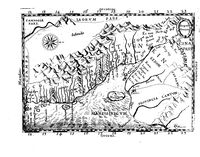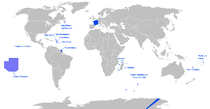Cochinchina
|
|||||||||||||||||||||||||||||||||||||||||
Cochinchina is a region encompassing the southern third of Vietnam whose principal city is Saigon. It was a French colony from 1862 to 1948. The later state of South Vietnam was created in 1954 by combining Cochinchina with southern Annam. In Vietnamese, the region is called Nam Bộ. Historically, it was Gia Định (1779–1832), Nam Kỳ (1834–1945), Nam Bộ (1945–48), Nam phần (1948–56), Nam Việt (1956–75), and later Miền Nam. In French, it was called la colonie de Cochinchine.
In the 17th century, Vietnam was divided between the Trịnh Lords to the north and the Nguyễn Lords to the south. The northern section was called Tonkin by Europeans, and the southern part called Cochinchina by most Europeans and Quinam by the Dutch.
During the French colonial period, the label moved further south, and came to refer to the southernmost part of Vietnam, controlled by Cambodia in prior centuries, and lying to its southeast. Its capital was at Saigon. The two other parts of Vietnam at the time were known as Annam and Tonkin.
The name "Cochin" derives from the Malay Kuchi which referred to all of Vietnam. This term was in turn derived from the Chinese jiao zhi, pronounced giao chỉ in Vietnam. "Cochinchina" derives from the need or desire to distinguish this Cochi/Kochi/Kuchi from the city (and princely state) of Kochi in India.[1]
Contents |
Pre-colonial history
The conquest of the south of present-day Vietnam was a long process of territorial acquisition by the Vietnamese. It is called Nam tiến by Vietnamese historians. Vietnam (then known as Đại Việt) nearly doubled its territory in 1470 under the great king Lê Thánh Tông, at the expense of the Champa. The next two hundred years was a time of territorial consolidation and civil war with only gradual expansion south.

As a result of a civil war that started in 1520, the Emperor of China sent a commission to study the political status of Annam in 1536. As a consequence of the delivered report, he declared war against the Mạc Dynasty. The nominal ruler of the Mạc died at the very time that the Chinese armies passed the frontiers of the kingdom in 1537, and his father, Mạc Đăng Dung (the real power in any case), hurried to submit to the Imperial will, and declared himself to be a vassal of China. The Chinese declared that both the Lê Dynasty and the Mạc had a right to part of the lands and so they recognized the Lê rule in the southern part of Vietnam while at the same time recognizing the Mạc rule in the northern part, which was called Tunquin (i.e. Tonkin). This was to be a feudatory state of China under the government of the Mạc.
However, this arrangement did not last long. In 1592, Trịnh Tùng, leading the Royal (Trịnh) army, conquered nearly all of the Mạc territory and moved the Lê kings back to the original capital of Hanoi. The Mạc only held on to a tiny part of north Vietnam until 1667, when Trịnh Tạc conquered the last Mạc lands.
In 1623, Nguyễn Phúc Nguyên, the lord of the (then) southern provinces of Vietnam, established a trading community at Saigon with the consent of the king of Cambodia. Over the next 50 years, Vietnamese control slowly expanded in this area but only gradually as the Nguyễn were fighting a protracted civil war with the Trịnh Lords in the north.
With the end of the war with the Trịnh, the Nguyễn were able to devote more effort (and military force) to conquest of the south. First, the remaining Champa territories were taken; next, the areas around the Mekong river were placed under Vietnamese control.
At least three wars were fought between the Nguyễn Lords and the Cambodian kings in the period 1715 to 1770 with the Vietnamese gaining more territory with each war. The wars all involved the much more powerful Siamese kings who fought on behalf of their vassals, the Cambodians.
In the late 1700s, Vietnam was briefly unified under the Tây Sơn. These were three brothers, former peasants, who succeeded in conquering first the lands of the Nguyễn and then the lands of the Trịnh. But final unification came under Nguyễn Phúc Ánh, a remarkably tenacious member of the Nguyễn noble family who fought for 25 years against the Tây Sơn and ultimately conquered the entire country in 1802. He ruled all of Vietnam under the name Gia Long.

Gia Long and his successors (see the Nguyễn Dynasty for details) conquered more lands from Cambodia and even annexed Phnom Penh and surrounding territory. However, the Vietnamese were forced to relinquish these conquests in the latter part of the 1800s.
Colonial Cochinchina (1864-1949)
For a series of complex reasons, the French government of Napoleon III, with the help of Spanish troops arriving from the Philippines (which was a Spanish colony at the time), decided to take over the southern part of Vietnam. In September 1858, France occupied Đà Nẵng (Tourane). On 18 February 1859, they conquered Saigon and three southern Vietnamese provinces: Biên Hòa, Gia Định and Dinh Tuong; on 13 April 1862, the Vietnamese government was forced to cede those territories to France.
In 1867, the provinces of Châu Đốc, Ha Tien and Vĩnh Long were added to French controlled territory. In 1864 all the French territories in southern Vietnam were declared to be the new French colony of Cochinchina, which would be governed by Admiral Jules Marie Dupré from 1868-1874.
In 1887, it became part of the Union of French Indochina. Fifty-one Vietnamese rebels were executed following the 1916 Cochinchina uprising. In 1933, the Spratly Islands were annexed to French Cochinchina. In July 1941, Japanese troops were based in French Cochinchina (a de facto occupation). After the Japanese surrendered in August 1945, Cochinchina was returned to French rule.

The "Autonomous Republic of Cochinchina" (République Autonome de Cochinchine), a French puppet state, was proclaimed June 1, 1946 to frustrate the Vietminh's desire to rule all of Vietnam. War between France and the Vietminh followed (1946–54). Cochinchina was renamed the "Republic of South Vietnam" in 1947, the "Provisional Central Government of Vietnam" in 1948, and the "State of Vietnam", with former emperor Bảo Đại as head of state, in 1949. The Bảo Đại government received international diplomatic recognition in 1950. France and the Vietminh concluded the Geneva Accords in 1954. As a result of this agreement, the southern half of the French protectorate of Annam was merged with the State of Vietnam, with the resulting state commonly referred to as South Vietnam. Meanwhile, northern Annam and the protectorate of Tonkin were awarded to the Vietminh. This area was afterwards known as North Vietnam.
1558-1976 summary
The Nguyễn Lords ruled the southern provinces of Vietnam from the city of Huế (in what was later called Annam by the French, though Annam historically refers to the northern part of modern Vietnam). The Tây Sơn also ruled the south but not from Saigon, instead they ruled from Đà Nẵng. Nguyễn Phúc Ánh ruled the united country of Vietnam from his ancestors’ capital of Huế. Cochinchina was never a single united administrative unit until the French seized it in the 1850s. Cochinchina was occupied by Japan during World War II (1941–45), but was restored to France afterwards. In 1955, after the French-Indochina War, Cochinchina was merged with southern Annam to form the Republic of Vietnam (South Vietnam).
See also
- French Indochina
- Tonkin
- Annam
- State of Vietnam
|
|||||||||||||||||||||||||||||||||||||||||||||||||||||||||||||||||||||||||||||||||||||||||||||||||||||||||||
References
- ↑ Reid, Anthony. Southeast Asia in the Age of Commerce. Vol 2: Expansion and Crisis. New Haven: Yale University Press, 1993. p211n.
Further reading
- Encyclopedia of Asian History, Volume 4 (Vietnam) 1988. Charles Scribner's Sons, New York.
- Vietnam - A Long History by Nguyễn Khắc Viện (1999). Hanoi, Thế Giới Publishers
- ArtHanoi Vietnamese money in historical context
- WorldStatesmen- Vietnam

